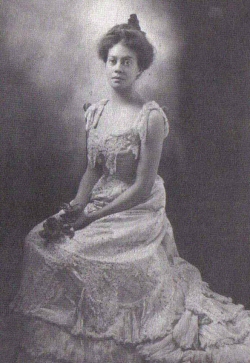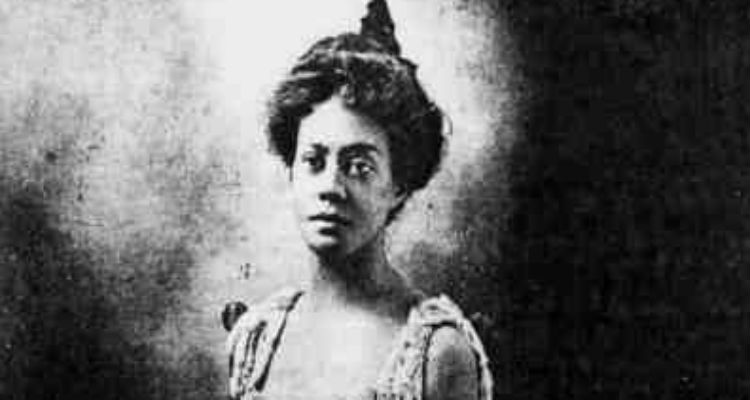Alice Ruth Moore, educator, author and social activist, was one of the prominent African Americans involved in the artistic flourishing of the Harlem Renaissance. An African American diarist of the early 20th century, she portrays the complicated reality of African American women and intellectuals, addressing topics such as racism, oppression, family, work, and sexuality.
 Alice Ruth Moore was born in New Orleans on July 19, 1875, the daughter of Patricia Wright, an African-American washerwoman and seamstress. Her father’s identity is disputed; her birth certificate lists a Monroe Moore, while other sources state that her father was a seaman named Joseph Moore or another man named John Moore. Neither potential father was a presence in Alice’s life. Moore attended public school in New Orleans, graduating from Straight University (later merged into Dillard University) in 1892 and started working as a teacher in the public school system of New Orleans.
Alice Ruth Moore was born in New Orleans on July 19, 1875, the daughter of Patricia Wright, an African-American washerwoman and seamstress. Her father’s identity is disputed; her birth certificate lists a Monroe Moore, while other sources state that her father was a seaman named Joseph Moore or another man named John Moore. Neither potential father was a presence in Alice’s life. Moore attended public school in New Orleans, graduating from Straight University (later merged into Dillard University) in 1892 and started working as a teacher in the public school system of New Orleans.
Moore developed her literary skills while teaching and soon became a prolific writer. Her African American, Anglo, Native American, and Creole heritage contributed to her complex understandings of gender, race, and ethnicity, subjects she often addressed in her work. Her first book, Violets and Other Tales, a collection of short stories, was published in 1895. About that time, Moore moved to Boston and then New York. She co-founded and taught at the White Rose Mission (White Rose Home for Girls) in Manhattan’s San Juan Hill neighborhood.
Later that year she published The Goodness of St. Rocque, and Other Short Stories. Throughout her career Alice Moore wrote four novels, two volumes of oratory, dramas, newspaper columns, two collections of essays, poems, short stories and reviews.
Alice Moore was married three times. Her first marriage was to Paul Laurence Dunbar, the poet. Dunbar noticed her picture and one of her poems in the Boston Monthly Review in 1895, and was instantly infatuated. They began a two year correspondence and finally met in February 1897. They were married on March 6, 1898 in New York City, New York and moved to Washington, D.C. The relationship proved stormy, exacerbated by Dunbar’s alcoholism and depression, and they separated in 1902. As husband and wife they shared literary pursuits and celebrity status in Washington, but their life together was marred by Paul’s physically abusive treatment of Alice. He was reported to have been disturbed by her lesbian affairs. In one incident he beat her nearly to death. She left him, and moved to Delaware. Paul Dunbar died in 1906.
In Delaware, Moore taught at Howard High School for more than a decade, and was involved in several intimate relationships with both men and women. She secretly married fellow teacher Henry A. Callis in 1910, but divorced him shortly after. It was not until her third marriage in 1916 to Robert J. Nelson, a journalist and political activist, that she was involved in a stable relationship. They stayed together for the rest of their lives.
Moore was coeditor and writer for the A.M.E. Review, an influential church publication produced by the African Methodist Episcopal Church (AME Church). She also published The Dunbar Speaker and Entertainer, a literary anthology for a Black audience. Moores also became an activist for African Americans’ and women’s rights, especially during the 1920s and 1930s. While she continued to write stories and poetry, she became more politically active in Wilmington, and put more effort into numerous articles and journalism on leading topics. In 1915, she was field organizer for the Middle Atlantic states for the woman’s suffrage movement. In 1918, she was field representative for the Woman’s Committee of the Council of Defense. In 1924, Moore campaigned for the passage of the Dyer Anti-Lynching Bill, but the Southern Democratic block in Congress defeated it. From about 1920 on, she made a commitment to journalism and was a highly successful columnist, with articles, essays and reviews appearing as well in newspapers, magazines, and academic journals. Her work reached a national audience which made her a popular public speaker.
Moore moved to Philadelphia in 1932, when her husband joined the Pennsylvania Athletic Commission. During this time, her health was in decline and she died from a heart ailment on September 18, 1935, at the age of sixty. She is interred at the Wilmington and Brandywine Cemetery in Wilmington, Delawar
Source:
https://en.wikipedia.org/wiki/Alice_Dunbar_Nelson
http://www.poetryfoundation.org/bio/alice-moore-dunbar-nelson
http://www.nps.gov/daav/learn/historyculture/aliceruthmooredunbarslifestory.htm



